MGT701 - Sunflower Foods: Enhancing Morale and Motivation via Teams
VerifiedAdded on 2023/06/11
|13
|3984
|135
Report
AI Summary
This report analyzes the organizational and behavioral issues affecting Sunflower Foods, including internal culture, low staff morale, and poor motivation. It explores the impact of these issues and applies frameworks like Hofstede's cultural dimensions and various motivation theories to provide recommendations. The report suggests changes to address these issues, focusing on team-based structures to improve morale and productivity. It emphasizes the importance of open communication, fair management practices, and employee recognition. Desklib provides students access to solved assignments like this, and many past papers to help with their studies.
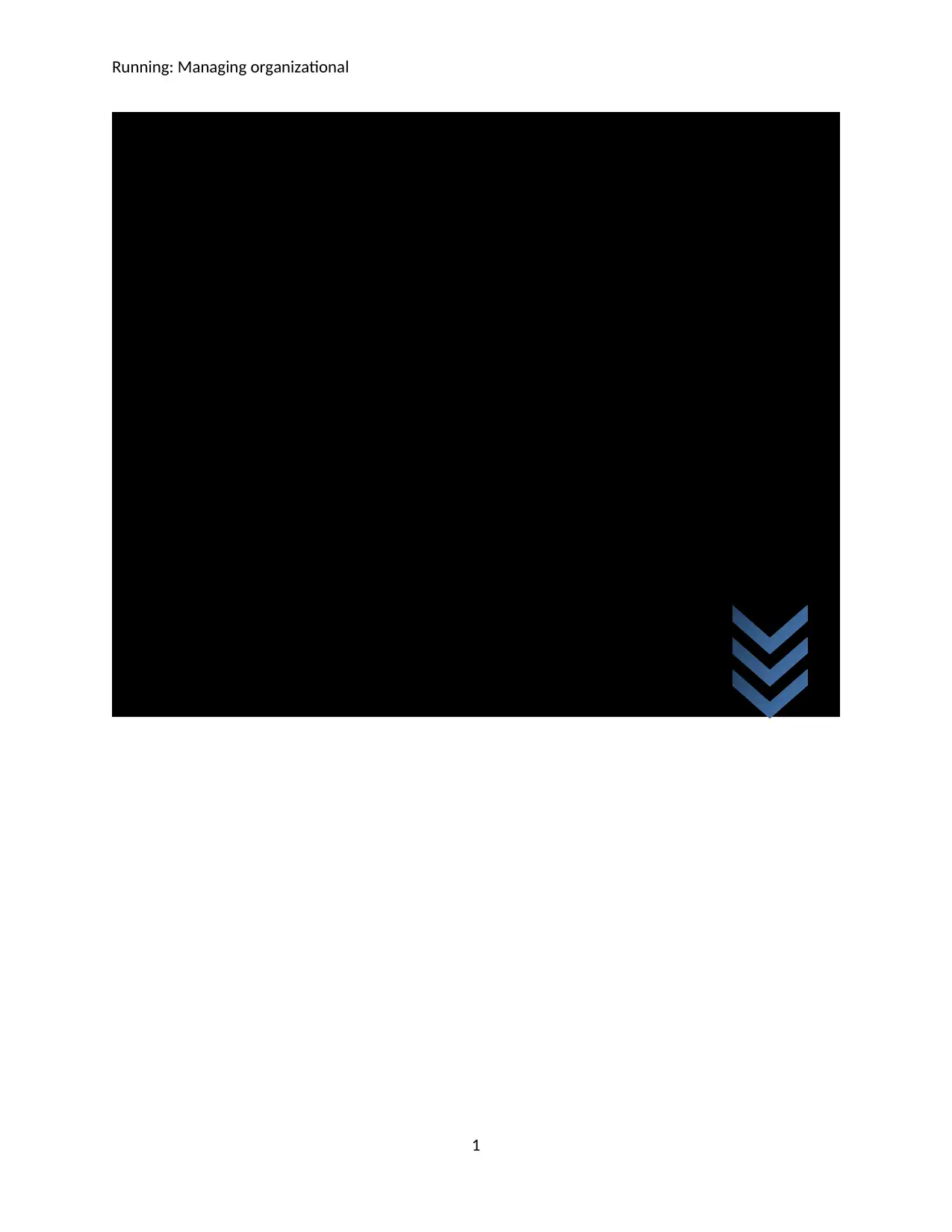
Running: Managing organizational
1
1
Paraphrase This Document
Need a fresh take? Get an instant paraphrase of this document with our AI Paraphraser
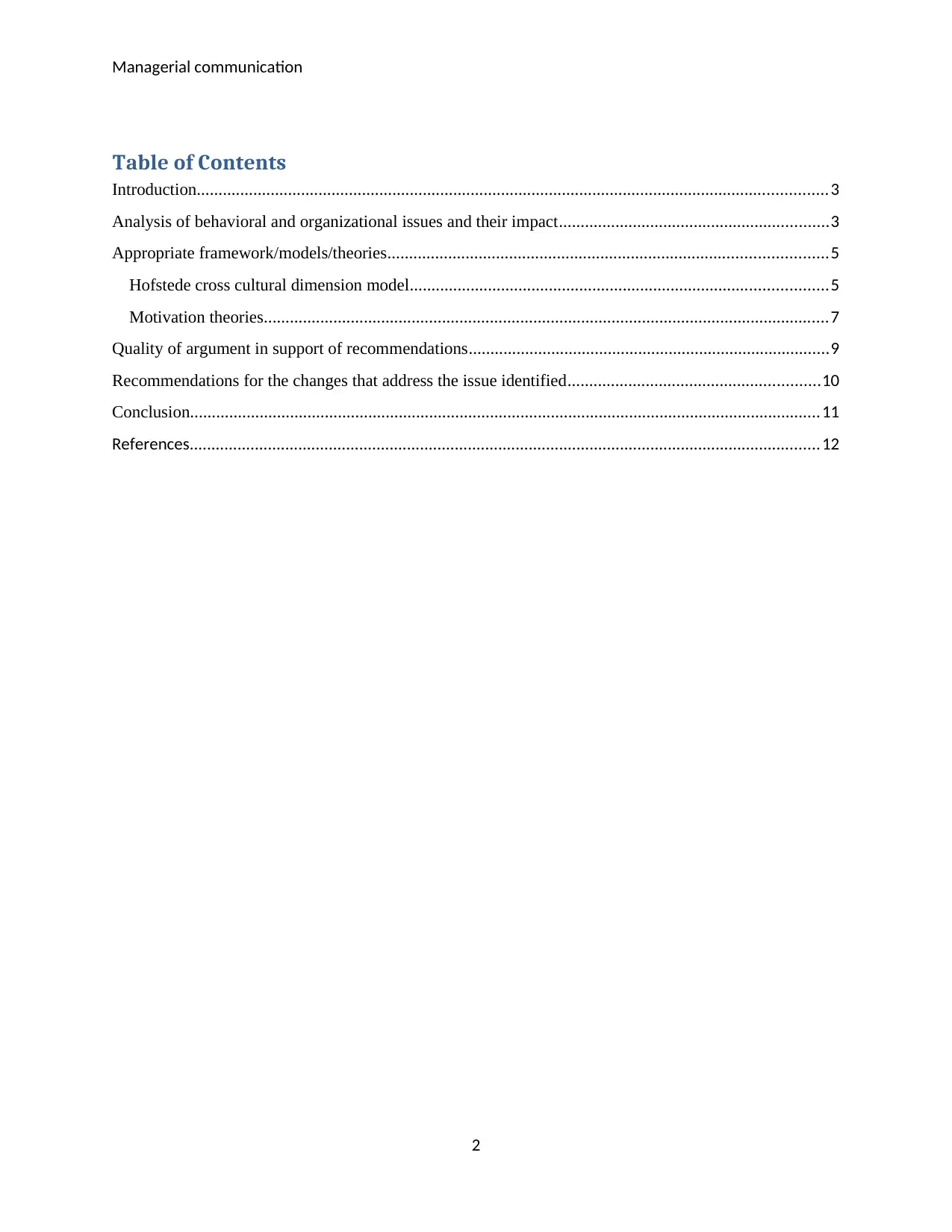
Managerial communication
Table of Contents
Introduction.................................................................................................................................................3
Analysis of behavioral and organizational issues and their impact..............................................................3
Appropriate framework/models/theories.....................................................................................................5
Hofstede cross cultural dimension model................................................................................................5
Motivation theories..................................................................................................................................7
Quality of argument in support of recommendations...................................................................................9
Recommendations for the changes that address the issue identified..........................................................10
Conclusion.................................................................................................................................................11
References.................................................................................................................................................12
2
Table of Contents
Introduction.................................................................................................................................................3
Analysis of behavioral and organizational issues and their impact..............................................................3
Appropriate framework/models/theories.....................................................................................................5
Hofstede cross cultural dimension model................................................................................................5
Motivation theories..................................................................................................................................7
Quality of argument in support of recommendations...................................................................................9
Recommendations for the changes that address the issue identified..........................................................10
Conclusion.................................................................................................................................................11
References.................................................................................................................................................12
2
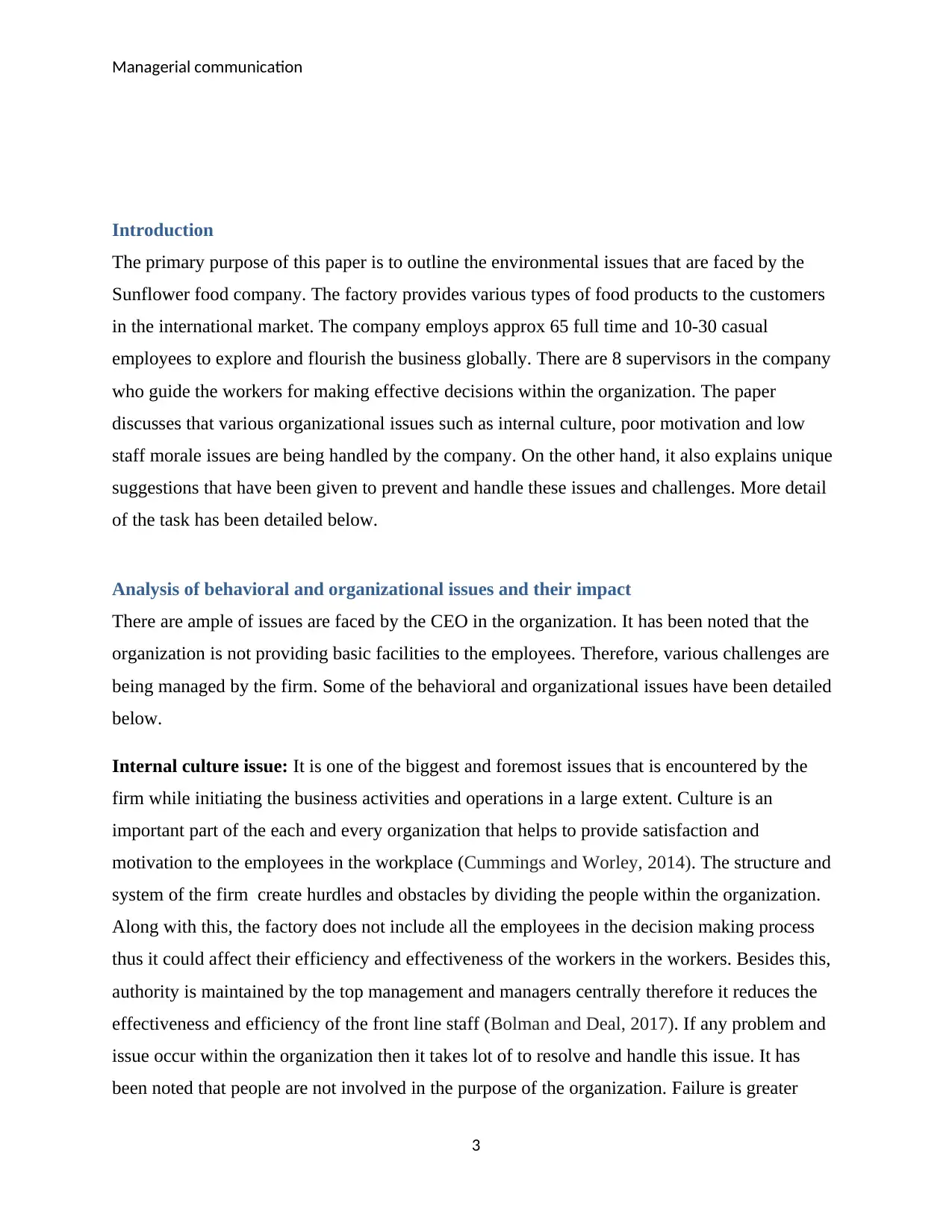
Managerial communication
Introduction
The primary purpose of this paper is to outline the environmental issues that are faced by the
Sunflower food company. The factory provides various types of food products to the customers
in the international market. The company employs approx 65 full time and 10-30 casual
employees to explore and flourish the business globally. There are 8 supervisors in the company
who guide the workers for making effective decisions within the organization. The paper
discusses that various organizational issues such as internal culture, poor motivation and low
staff morale issues are being handled by the company. On the other hand, it also explains unique
suggestions that have been given to prevent and handle these issues and challenges. More detail
of the task has been detailed below.
Analysis of behavioral and organizational issues and their impact
There are ample of issues are faced by the CEO in the organization. It has been noted that the
organization is not providing basic facilities to the employees. Therefore, various challenges are
being managed by the firm. Some of the behavioral and organizational issues have been detailed
below.
Internal culture issue: It is one of the biggest and foremost issues that is encountered by the
firm while initiating the business activities and operations in a large extent. Culture is an
important part of the each and every organization that helps to provide satisfaction and
motivation to the employees in the workplace (Cummings and Worley, 2014). The structure and
system of the firm create hurdles and obstacles by dividing the people within the organization.
Along with this, the factory does not include all the employees in the decision making process
thus it could affect their efficiency and effectiveness of the workers in the workers. Besides this,
authority is maintained by the top management and managers centrally therefore it reduces the
effectiveness and efficiency of the front line staff (Bolman and Deal, 2017). If any problem and
issue occur within the organization then it takes lot of to resolve and handle this issue. It has
been noted that people are not involved in the purpose of the organization. Failure is greater
3
Introduction
The primary purpose of this paper is to outline the environmental issues that are faced by the
Sunflower food company. The factory provides various types of food products to the customers
in the international market. The company employs approx 65 full time and 10-30 casual
employees to explore and flourish the business globally. There are 8 supervisors in the company
who guide the workers for making effective decisions within the organization. The paper
discusses that various organizational issues such as internal culture, poor motivation and low
staff morale issues are being handled by the company. On the other hand, it also explains unique
suggestions that have been given to prevent and handle these issues and challenges. More detail
of the task has been detailed below.
Analysis of behavioral and organizational issues and their impact
There are ample of issues are faced by the CEO in the organization. It has been noted that the
organization is not providing basic facilities to the employees. Therefore, various challenges are
being managed by the firm. Some of the behavioral and organizational issues have been detailed
below.
Internal culture issue: It is one of the biggest and foremost issues that is encountered by the
firm while initiating the business activities and operations in a large extent. Culture is an
important part of the each and every organization that helps to provide satisfaction and
motivation to the employees in the workplace (Cummings and Worley, 2014). The structure and
system of the firm create hurdles and obstacles by dividing the people within the organization.
Along with this, the factory does not include all the employees in the decision making process
thus it could affect their efficiency and effectiveness of the workers in the workers. Besides this,
authority is maintained by the top management and managers centrally therefore it reduces the
effectiveness and efficiency of the front line staff (Bolman and Deal, 2017). If any problem and
issue occur within the organization then it takes lot of to resolve and handle this issue. It has
been noted that people are not involved in the purpose of the organization. Failure is greater
3
⊘ This is a preview!⊘
Do you want full access?
Subscribe today to unlock all pages.

Trusted by 1+ million students worldwide
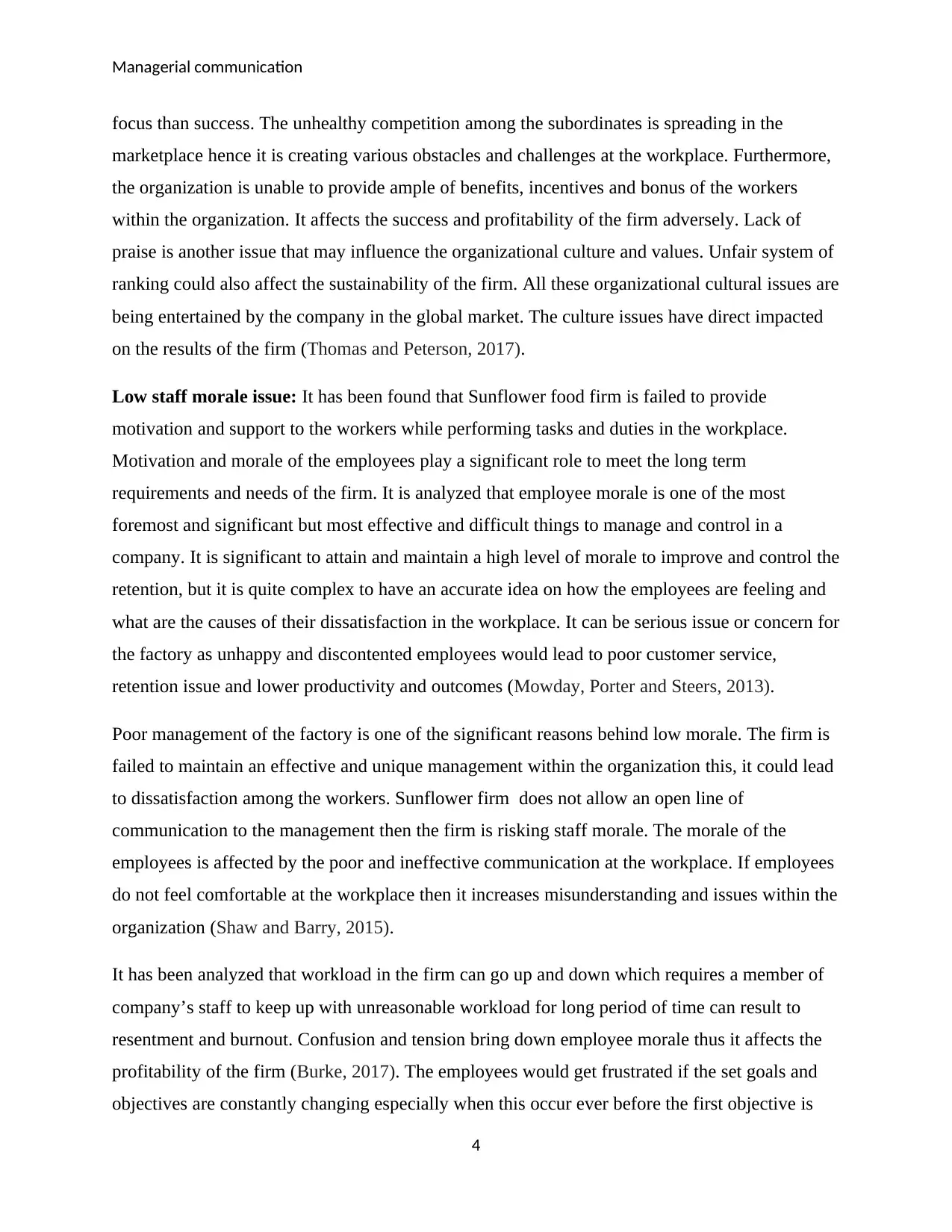
Managerial communication
focus than success. The unhealthy competition among the subordinates is spreading in the
marketplace hence it is creating various obstacles and challenges at the workplace. Furthermore,
the organization is unable to provide ample of benefits, incentives and bonus of the workers
within the organization. It affects the success and profitability of the firm adversely. Lack of
praise is another issue that may influence the organizational culture and values. Unfair system of
ranking could also affect the sustainability of the firm. All these organizational cultural issues are
being entertained by the company in the global market. The culture issues have direct impacted
on the results of the firm (Thomas and Peterson, 2017).
Low staff morale issue: It has been found that Sunflower food firm is failed to provide
motivation and support to the workers while performing tasks and duties in the workplace.
Motivation and morale of the employees play a significant role to meet the long term
requirements and needs of the firm. It is analyzed that employee morale is one of the most
foremost and significant but most effective and difficult things to manage and control in a
company. It is significant to attain and maintain a high level of morale to improve and control the
retention, but it is quite complex to have an accurate idea on how the employees are feeling and
what are the causes of their dissatisfaction in the workplace. It can be serious issue or concern for
the factory as unhappy and discontented employees would lead to poor customer service,
retention issue and lower productivity and outcomes (Mowday, Porter and Steers, 2013).
Poor management of the factory is one of the significant reasons behind low morale. The firm is
failed to maintain an effective and unique management within the organization this, it could lead
to dissatisfaction among the workers. Sunflower firm does not allow an open line of
communication to the management then the firm is risking staff morale. The morale of the
employees is affected by the poor and ineffective communication at the workplace. If employees
do not feel comfortable at the workplace then it increases misunderstanding and issues within the
organization (Shaw and Barry, 2015).
It has been analyzed that workload in the firm can go up and down which requires a member of
company’s staff to keep up with unreasonable workload for long period of time can result to
resentment and burnout. Confusion and tension bring down employee morale thus it affects the
profitability of the firm (Burke, 2017). The employees would get frustrated if the set goals and
objectives are constantly changing especially when this occur ever before the first objective is
4
focus than success. The unhealthy competition among the subordinates is spreading in the
marketplace hence it is creating various obstacles and challenges at the workplace. Furthermore,
the organization is unable to provide ample of benefits, incentives and bonus of the workers
within the organization. It affects the success and profitability of the firm adversely. Lack of
praise is another issue that may influence the organizational culture and values. Unfair system of
ranking could also affect the sustainability of the firm. All these organizational cultural issues are
being entertained by the company in the global market. The culture issues have direct impacted
on the results of the firm (Thomas and Peterson, 2017).
Low staff morale issue: It has been found that Sunflower food firm is failed to provide
motivation and support to the workers while performing tasks and duties in the workplace.
Motivation and morale of the employees play a significant role to meet the long term
requirements and needs of the firm. It is analyzed that employee morale is one of the most
foremost and significant but most effective and difficult things to manage and control in a
company. It is significant to attain and maintain a high level of morale to improve and control the
retention, but it is quite complex to have an accurate idea on how the employees are feeling and
what are the causes of their dissatisfaction in the workplace. It can be serious issue or concern for
the factory as unhappy and discontented employees would lead to poor customer service,
retention issue and lower productivity and outcomes (Mowday, Porter and Steers, 2013).
Poor management of the factory is one of the significant reasons behind low morale. The firm is
failed to maintain an effective and unique management within the organization this, it could lead
to dissatisfaction among the workers. Sunflower firm does not allow an open line of
communication to the management then the firm is risking staff morale. The morale of the
employees is affected by the poor and ineffective communication at the workplace. If employees
do not feel comfortable at the workplace then it increases misunderstanding and issues within the
organization (Shaw and Barry, 2015).
It has been analyzed that workload in the firm can go up and down which requires a member of
company’s staff to keep up with unreasonable workload for long period of time can result to
resentment and burnout. Confusion and tension bring down employee morale thus it affects the
profitability of the firm (Burke, 2017). The employees would get frustrated if the set goals and
objectives are constantly changing especially when this occur ever before the first objective is
4
Paraphrase This Document
Need a fresh take? Get an instant paraphrase of this document with our AI Paraphraser
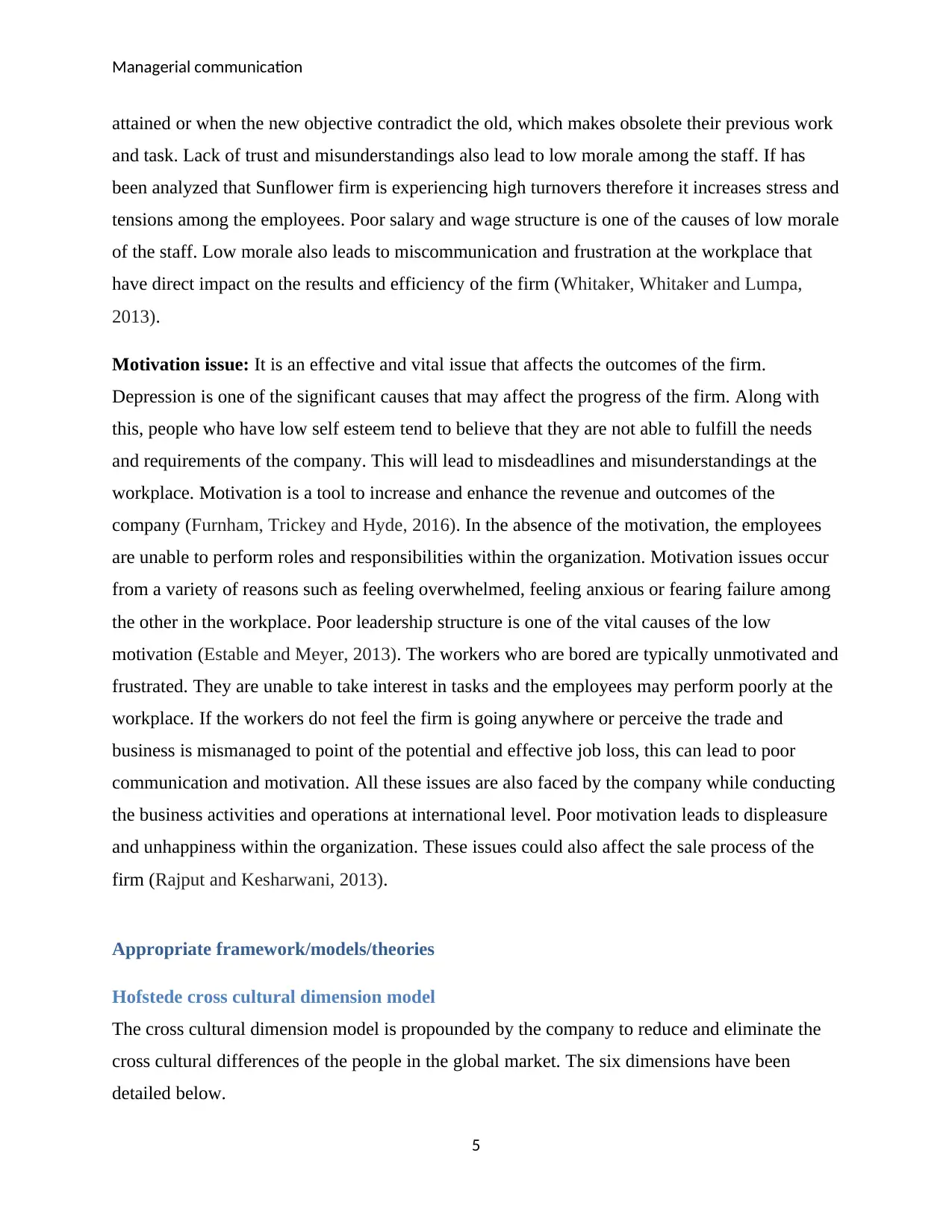
Managerial communication
attained or when the new objective contradict the old, which makes obsolete their previous work
and task. Lack of trust and misunderstandings also lead to low morale among the staff. If has
been analyzed that Sunflower firm is experiencing high turnovers therefore it increases stress and
tensions among the employees. Poor salary and wage structure is one of the causes of low morale
of the staff. Low morale also leads to miscommunication and frustration at the workplace that
have direct impact on the results and efficiency of the firm (Whitaker, Whitaker and Lumpa,
2013).
Motivation issue: It is an effective and vital issue that affects the outcomes of the firm.
Depression is one of the significant causes that may affect the progress of the firm. Along with
this, people who have low self esteem tend to believe that they are not able to fulfill the needs
and requirements of the company. This will lead to misdeadlines and misunderstandings at the
workplace. Motivation is a tool to increase and enhance the revenue and outcomes of the
company (Furnham, Trickey and Hyde, 2016). In the absence of the motivation, the employees
are unable to perform roles and responsibilities within the organization. Motivation issues occur
from a variety of reasons such as feeling overwhelmed, feeling anxious or fearing failure among
the other in the workplace. Poor leadership structure is one of the vital causes of the low
motivation (Estable and Meyer, 2013). The workers who are bored are typically unmotivated and
frustrated. They are unable to take interest in tasks and the employees may perform poorly at the
workplace. If the workers do not feel the firm is going anywhere or perceive the trade and
business is mismanaged to point of the potential and effective job loss, this can lead to poor
communication and motivation. All these issues are also faced by the company while conducting
the business activities and operations at international level. Poor motivation leads to displeasure
and unhappiness within the organization. These issues could also affect the sale process of the
firm (Rajput and Kesharwani, 2013).
Appropriate framework/models/theories
Hofstede cross cultural dimension model
The cross cultural dimension model is propounded by the company to reduce and eliminate the
cross cultural differences of the people in the global market. The six dimensions have been
detailed below.
5
attained or when the new objective contradict the old, which makes obsolete their previous work
and task. Lack of trust and misunderstandings also lead to low morale among the staff. If has
been analyzed that Sunflower firm is experiencing high turnovers therefore it increases stress and
tensions among the employees. Poor salary and wage structure is one of the causes of low morale
of the staff. Low morale also leads to miscommunication and frustration at the workplace that
have direct impact on the results and efficiency of the firm (Whitaker, Whitaker and Lumpa,
2013).
Motivation issue: It is an effective and vital issue that affects the outcomes of the firm.
Depression is one of the significant causes that may affect the progress of the firm. Along with
this, people who have low self esteem tend to believe that they are not able to fulfill the needs
and requirements of the company. This will lead to misdeadlines and misunderstandings at the
workplace. Motivation is a tool to increase and enhance the revenue and outcomes of the
company (Furnham, Trickey and Hyde, 2016). In the absence of the motivation, the employees
are unable to perform roles and responsibilities within the organization. Motivation issues occur
from a variety of reasons such as feeling overwhelmed, feeling anxious or fearing failure among
the other in the workplace. Poor leadership structure is one of the vital causes of the low
motivation (Estable and Meyer, 2013). The workers who are bored are typically unmotivated and
frustrated. They are unable to take interest in tasks and the employees may perform poorly at the
workplace. If the workers do not feel the firm is going anywhere or perceive the trade and
business is mismanaged to point of the potential and effective job loss, this can lead to poor
communication and motivation. All these issues are also faced by the company while conducting
the business activities and operations at international level. Poor motivation leads to displeasure
and unhappiness within the organization. These issues could also affect the sale process of the
firm (Rajput and Kesharwani, 2013).
Appropriate framework/models/theories
Hofstede cross cultural dimension model
The cross cultural dimension model is propounded by the company to reduce and eliminate the
cross cultural differences of the people in the global market. The six dimensions have been
detailed below.
5
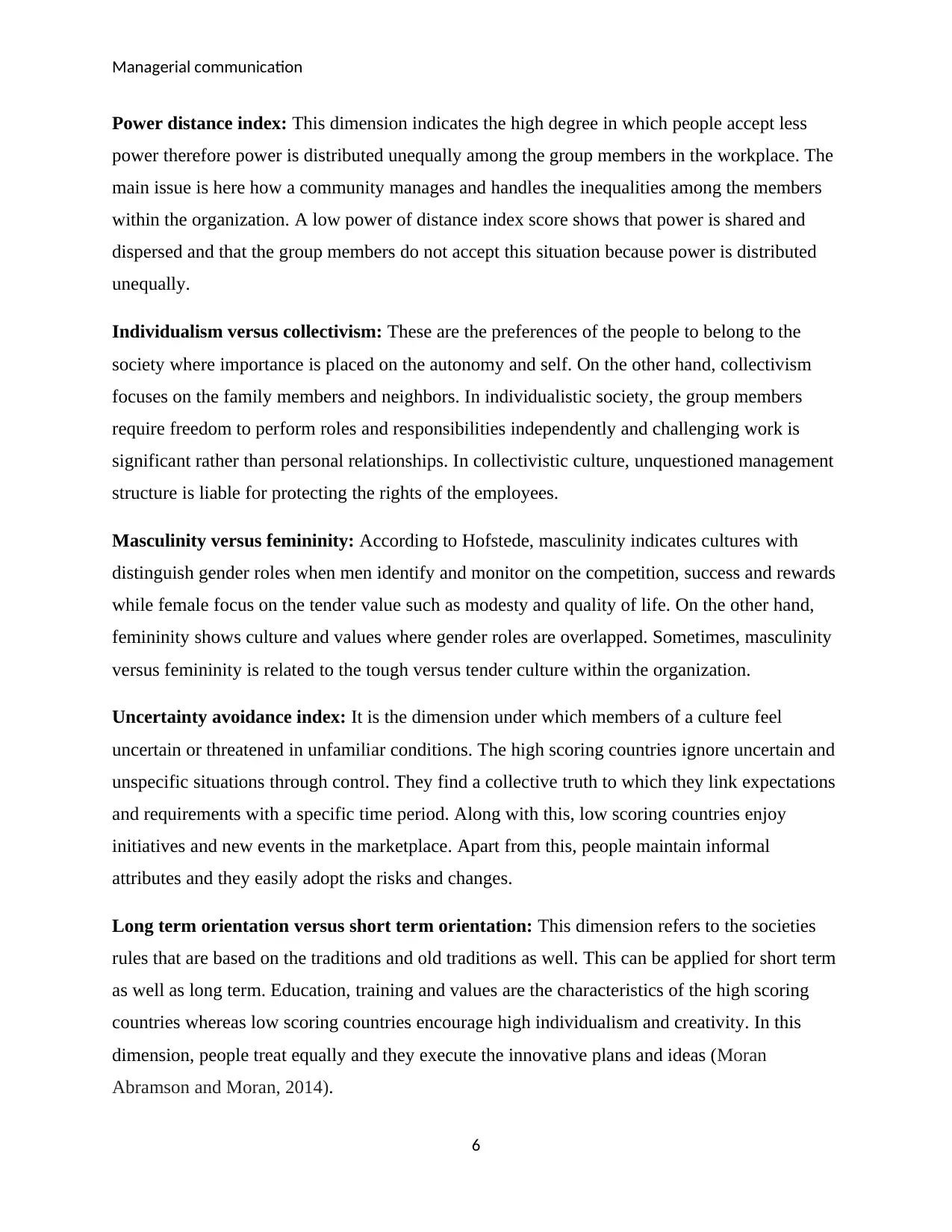
Managerial communication
Power distance index: This dimension indicates the high degree in which people accept less
power therefore power is distributed unequally among the group members in the workplace. The
main issue is here how a community manages and handles the inequalities among the members
within the organization. A low power of distance index score shows that power is shared and
dispersed and that the group members do not accept this situation because power is distributed
unequally.
Individualism versus collectivism: These are the preferences of the people to belong to the
society where importance is placed on the autonomy and self. On the other hand, collectivism
focuses on the family members and neighbors. In individualistic society, the group members
require freedom to perform roles and responsibilities independently and challenging work is
significant rather than personal relationships. In collectivistic culture, unquestioned management
structure is liable for protecting the rights of the employees.
Masculinity versus femininity: According to Hofstede, masculinity indicates cultures with
distinguish gender roles when men identify and monitor on the competition, success and rewards
while female focus on the tender value such as modesty and quality of life. On the other hand,
femininity shows culture and values where gender roles are overlapped. Sometimes, masculinity
versus femininity is related to the tough versus tender culture within the organization.
Uncertainty avoidance index: It is the dimension under which members of a culture feel
uncertain or threatened in unfamiliar conditions. The high scoring countries ignore uncertain and
unspecific situations through control. They find a collective truth to which they link expectations
and requirements with a specific time period. Along with this, low scoring countries enjoy
initiatives and new events in the marketplace. Apart from this, people maintain informal
attributes and they easily adopt the risks and changes.
Long term orientation versus short term orientation: This dimension refers to the societies
rules that are based on the traditions and old traditions as well. This can be applied for short term
as well as long term. Education, training and values are the characteristics of the high scoring
countries whereas low scoring countries encourage high individualism and creativity. In this
dimension, people treat equally and they execute the innovative plans and ideas (Moran
Abramson and Moran, 2014).
6
Power distance index: This dimension indicates the high degree in which people accept less
power therefore power is distributed unequally among the group members in the workplace. The
main issue is here how a community manages and handles the inequalities among the members
within the organization. A low power of distance index score shows that power is shared and
dispersed and that the group members do not accept this situation because power is distributed
unequally.
Individualism versus collectivism: These are the preferences of the people to belong to the
society where importance is placed on the autonomy and self. On the other hand, collectivism
focuses on the family members and neighbors. In individualistic society, the group members
require freedom to perform roles and responsibilities independently and challenging work is
significant rather than personal relationships. In collectivistic culture, unquestioned management
structure is liable for protecting the rights of the employees.
Masculinity versus femininity: According to Hofstede, masculinity indicates cultures with
distinguish gender roles when men identify and monitor on the competition, success and rewards
while female focus on the tender value such as modesty and quality of life. On the other hand,
femininity shows culture and values where gender roles are overlapped. Sometimes, masculinity
versus femininity is related to the tough versus tender culture within the organization.
Uncertainty avoidance index: It is the dimension under which members of a culture feel
uncertain or threatened in unfamiliar conditions. The high scoring countries ignore uncertain and
unspecific situations through control. They find a collective truth to which they link expectations
and requirements with a specific time period. Along with this, low scoring countries enjoy
initiatives and new events in the marketplace. Apart from this, people maintain informal
attributes and they easily adopt the risks and changes.
Long term orientation versus short term orientation: This dimension refers to the societies
rules that are based on the traditions and old traditions as well. This can be applied for short term
as well as long term. Education, training and values are the characteristics of the high scoring
countries whereas low scoring countries encourage high individualism and creativity. In this
dimension, people treat equally and they execute the innovative plans and ideas (Moran
Abramson and Moran, 2014).
6
⊘ This is a preview!⊘
Do you want full access?
Subscribe today to unlock all pages.

Trusted by 1+ million students worldwide
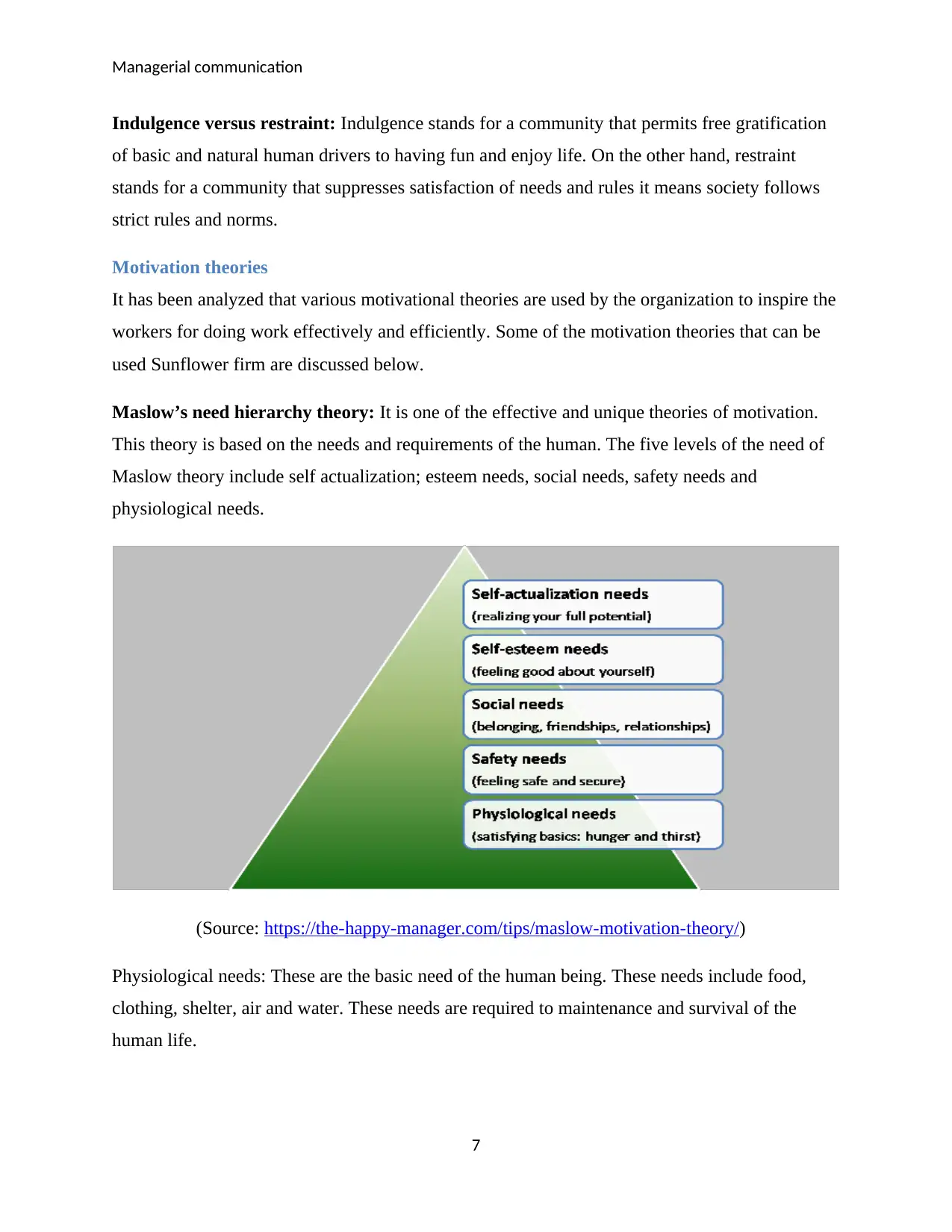
Managerial communication
Indulgence versus restraint: Indulgence stands for a community that permits free gratification
of basic and natural human drivers to having fun and enjoy life. On the other hand, restraint
stands for a community that suppresses satisfaction of needs and rules it means society follows
strict rules and norms.
Motivation theories
It has been analyzed that various motivational theories are used by the organization to inspire the
workers for doing work effectively and efficiently. Some of the motivation theories that can be
used Sunflower firm are discussed below.
Maslow’s need hierarchy theory: It is one of the effective and unique theories of motivation.
This theory is based on the needs and requirements of the human. The five levels of the need of
Maslow theory include self actualization; esteem needs, social needs, safety needs and
physiological needs.
(Source: https://the-happy-manager.com/tips/maslow-motivation-theory/)
Physiological needs: These are the basic need of the human being. These needs include food,
clothing, shelter, air and water. These needs are required to maintenance and survival of the
human life.
7
Indulgence versus restraint: Indulgence stands for a community that permits free gratification
of basic and natural human drivers to having fun and enjoy life. On the other hand, restraint
stands for a community that suppresses satisfaction of needs and rules it means society follows
strict rules and norms.
Motivation theories
It has been analyzed that various motivational theories are used by the organization to inspire the
workers for doing work effectively and efficiently. Some of the motivation theories that can be
used Sunflower firm are discussed below.
Maslow’s need hierarchy theory: It is one of the effective and unique theories of motivation.
This theory is based on the needs and requirements of the human. The five levels of the need of
Maslow theory include self actualization; esteem needs, social needs, safety needs and
physiological needs.
(Source: https://the-happy-manager.com/tips/maslow-motivation-theory/)
Physiological needs: These are the basic need of the human being. These needs include food,
clothing, shelter, air and water. These needs are required to maintenance and survival of the
human life.
7
Paraphrase This Document
Need a fresh take? Get an instant paraphrase of this document with our AI Paraphraser
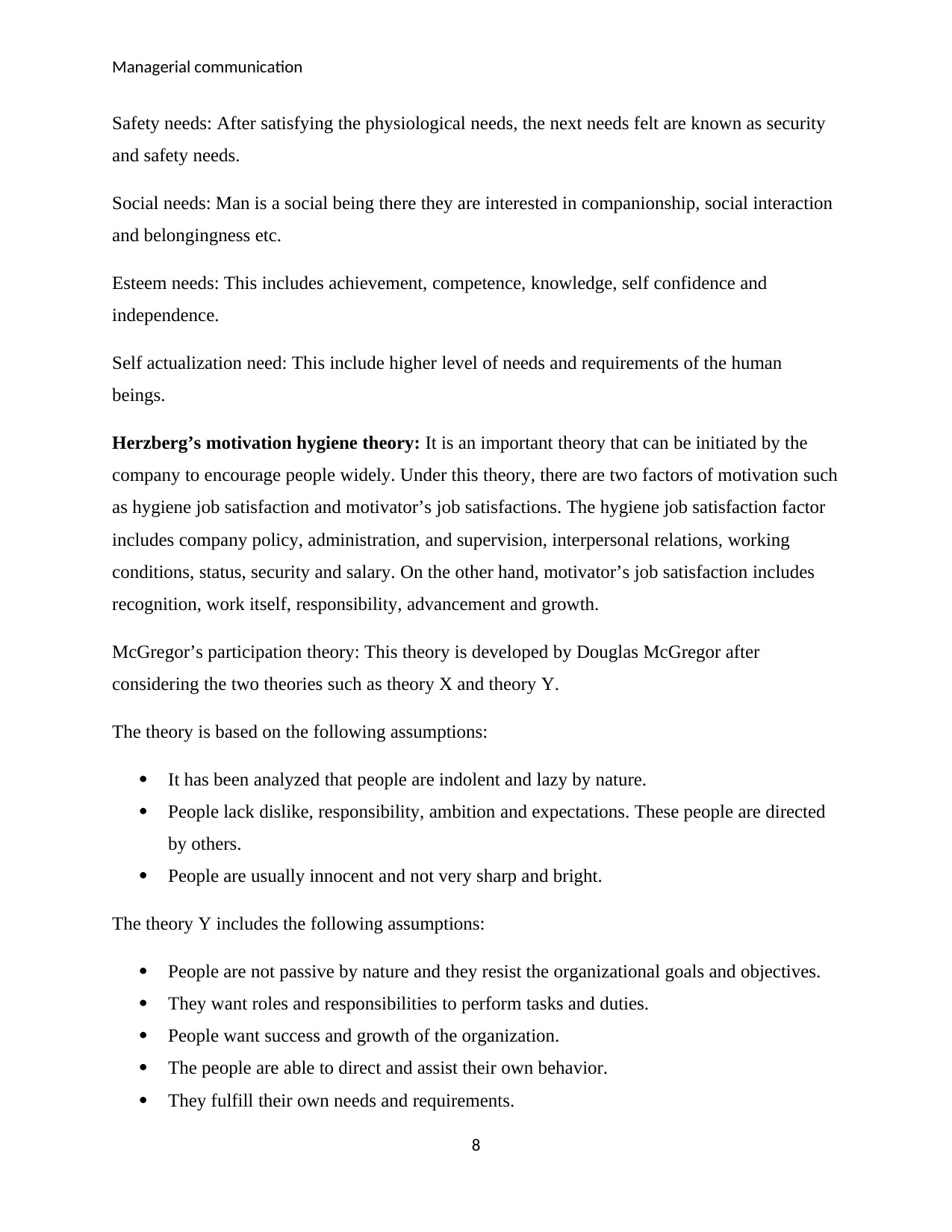
Managerial communication
Safety needs: After satisfying the physiological needs, the next needs felt are known as security
and safety needs.
Social needs: Man is a social being there they are interested in companionship, social interaction
and belongingness etc.
Esteem needs: This includes achievement, competence, knowledge, self confidence and
independence.
Self actualization need: This include higher level of needs and requirements of the human
beings.
Herzberg’s motivation hygiene theory: It is an important theory that can be initiated by the
company to encourage people widely. Under this theory, there are two factors of motivation such
as hygiene job satisfaction and motivator’s job satisfactions. The hygiene job satisfaction factor
includes company policy, administration, and supervision, interpersonal relations, working
conditions, status, security and salary. On the other hand, motivator’s job satisfaction includes
recognition, work itself, responsibility, advancement and growth.
McGregor’s participation theory: This theory is developed by Douglas McGregor after
considering the two theories such as theory X and theory Y.
The theory is based on the following assumptions:
It has been analyzed that people are indolent and lazy by nature.
People lack dislike, responsibility, ambition and expectations. These people are directed
by others.
People are usually innocent and not very sharp and bright.
The theory Y includes the following assumptions:
People are not passive by nature and they resist the organizational goals and objectives.
They want roles and responsibilities to perform tasks and duties.
People want success and growth of the organization.
The people are able to direct and assist their own behavior.
They fulfill their own needs and requirements.
8
Safety needs: After satisfying the physiological needs, the next needs felt are known as security
and safety needs.
Social needs: Man is a social being there they are interested in companionship, social interaction
and belongingness etc.
Esteem needs: This includes achievement, competence, knowledge, self confidence and
independence.
Self actualization need: This include higher level of needs and requirements of the human
beings.
Herzberg’s motivation hygiene theory: It is an important theory that can be initiated by the
company to encourage people widely. Under this theory, there are two factors of motivation such
as hygiene job satisfaction and motivator’s job satisfactions. The hygiene job satisfaction factor
includes company policy, administration, and supervision, interpersonal relations, working
conditions, status, security and salary. On the other hand, motivator’s job satisfaction includes
recognition, work itself, responsibility, advancement and growth.
McGregor’s participation theory: This theory is developed by Douglas McGregor after
considering the two theories such as theory X and theory Y.
The theory is based on the following assumptions:
It has been analyzed that people are indolent and lazy by nature.
People lack dislike, responsibility, ambition and expectations. These people are directed
by others.
People are usually innocent and not very sharp and bright.
The theory Y includes the following assumptions:
People are not passive by nature and they resist the organizational goals and objectives.
They want roles and responsibilities to perform tasks and duties.
People want success and growth of the organization.
The people are able to direct and assist their own behavior.
They fulfill their own needs and requirements.
8
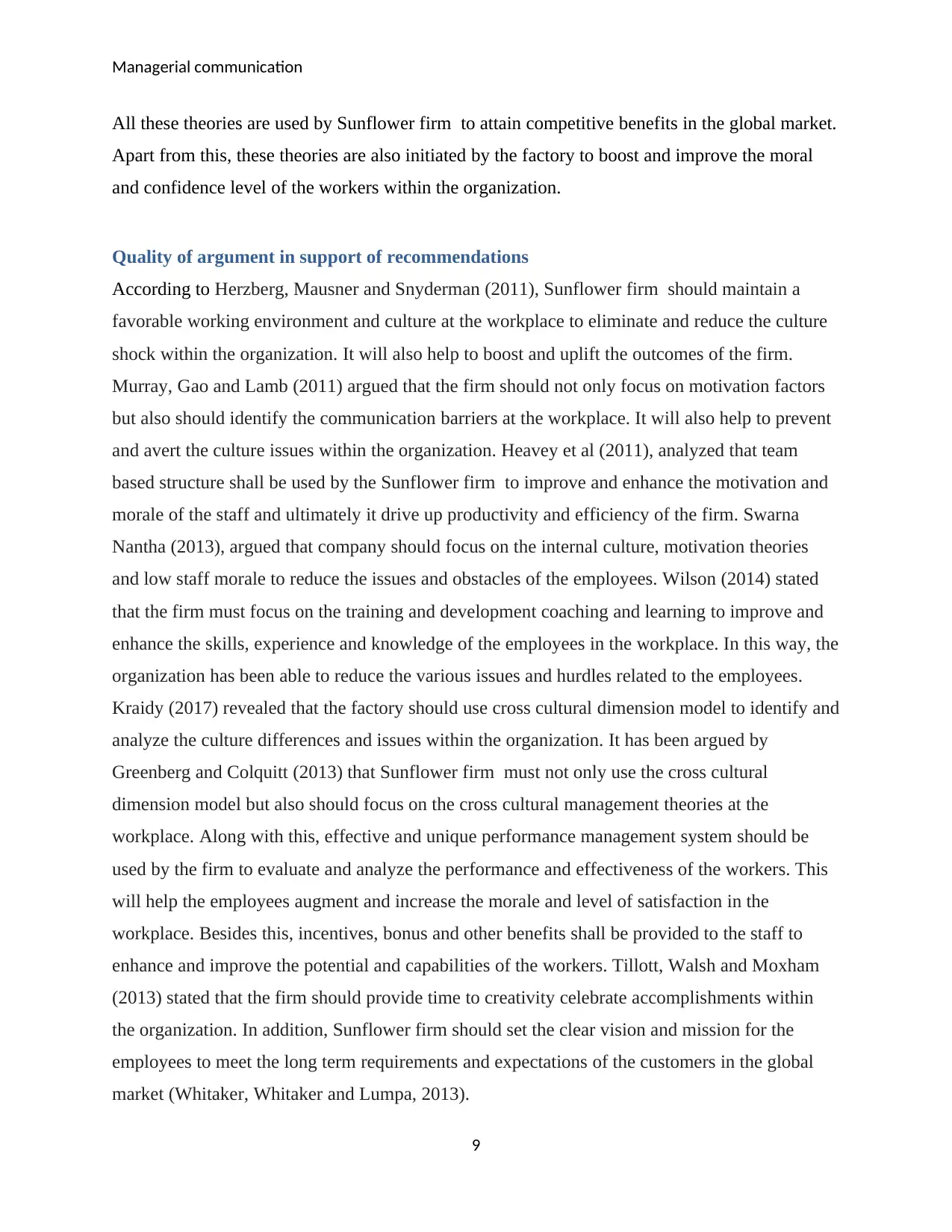
Managerial communication
All these theories are used by Sunflower firm to attain competitive benefits in the global market.
Apart from this, these theories are also initiated by the factory to boost and improve the moral
and confidence level of the workers within the organization.
Quality of argument in support of recommendations
According to Herzberg, Mausner and Snyderman (2011), Sunflower firm should maintain a
favorable working environment and culture at the workplace to eliminate and reduce the culture
shock within the organization. It will also help to boost and uplift the outcomes of the firm.
Murray, Gao and Lamb (2011) argued that the firm should not only focus on motivation factors
but also should identify the communication barriers at the workplace. It will also help to prevent
and avert the culture issues within the organization. Heavey et al (2011), analyzed that team
based structure shall be used by the Sunflower firm to improve and enhance the motivation and
morale of the staff and ultimately it drive up productivity and efficiency of the firm. Swarna
Nantha (2013), argued that company should focus on the internal culture, motivation theories
and low staff morale to reduce the issues and obstacles of the employees. Wilson (2014) stated
that the firm must focus on the training and development coaching and learning to improve and
enhance the skills, experience and knowledge of the employees in the workplace. In this way, the
organization has been able to reduce the various issues and hurdles related to the employees.
Kraidy (2017) revealed that the factory should use cross cultural dimension model to identify and
analyze the culture differences and issues within the organization. It has been argued by
Greenberg and Colquitt (2013) that Sunflower firm must not only use the cross cultural
dimension model but also should focus on the cross cultural management theories at the
workplace. Along with this, effective and unique performance management system should be
used by the firm to evaluate and analyze the performance and effectiveness of the workers. This
will help the employees augment and increase the morale and level of satisfaction in the
workplace. Besides this, incentives, bonus and other benefits shall be provided to the staff to
enhance and improve the potential and capabilities of the workers. Tillott, Walsh and Moxham
(2013) stated that the firm should provide time to creativity celebrate accomplishments within
the organization. In addition, Sunflower firm should set the clear vision and mission for the
employees to meet the long term requirements and expectations of the customers in the global
market (Whitaker, Whitaker and Lumpa, 2013).
9
All these theories are used by Sunflower firm to attain competitive benefits in the global market.
Apart from this, these theories are also initiated by the factory to boost and improve the moral
and confidence level of the workers within the organization.
Quality of argument in support of recommendations
According to Herzberg, Mausner and Snyderman (2011), Sunflower firm should maintain a
favorable working environment and culture at the workplace to eliminate and reduce the culture
shock within the organization. It will also help to boost and uplift the outcomes of the firm.
Murray, Gao and Lamb (2011) argued that the firm should not only focus on motivation factors
but also should identify the communication barriers at the workplace. It will also help to prevent
and avert the culture issues within the organization. Heavey et al (2011), analyzed that team
based structure shall be used by the Sunflower firm to improve and enhance the motivation and
morale of the staff and ultimately it drive up productivity and efficiency of the firm. Swarna
Nantha (2013), argued that company should focus on the internal culture, motivation theories
and low staff morale to reduce the issues and obstacles of the employees. Wilson (2014) stated
that the firm must focus on the training and development coaching and learning to improve and
enhance the skills, experience and knowledge of the employees in the workplace. In this way, the
organization has been able to reduce the various issues and hurdles related to the employees.
Kraidy (2017) revealed that the factory should use cross cultural dimension model to identify and
analyze the culture differences and issues within the organization. It has been argued by
Greenberg and Colquitt (2013) that Sunflower firm must not only use the cross cultural
dimension model but also should focus on the cross cultural management theories at the
workplace. Along with this, effective and unique performance management system should be
used by the firm to evaluate and analyze the performance and effectiveness of the workers. This
will help the employees augment and increase the morale and level of satisfaction in the
workplace. Besides this, incentives, bonus and other benefits shall be provided to the staff to
enhance and improve the potential and capabilities of the workers. Tillott, Walsh and Moxham
(2013) stated that the firm should provide time to creativity celebrate accomplishments within
the organization. In addition, Sunflower firm should set the clear vision and mission for the
employees to meet the long term requirements and expectations of the customers in the global
market (Whitaker, Whitaker and Lumpa, 2013).
9
⊘ This is a preview!⊘
Do you want full access?
Subscribe today to unlock all pages.

Trusted by 1+ million students worldwide
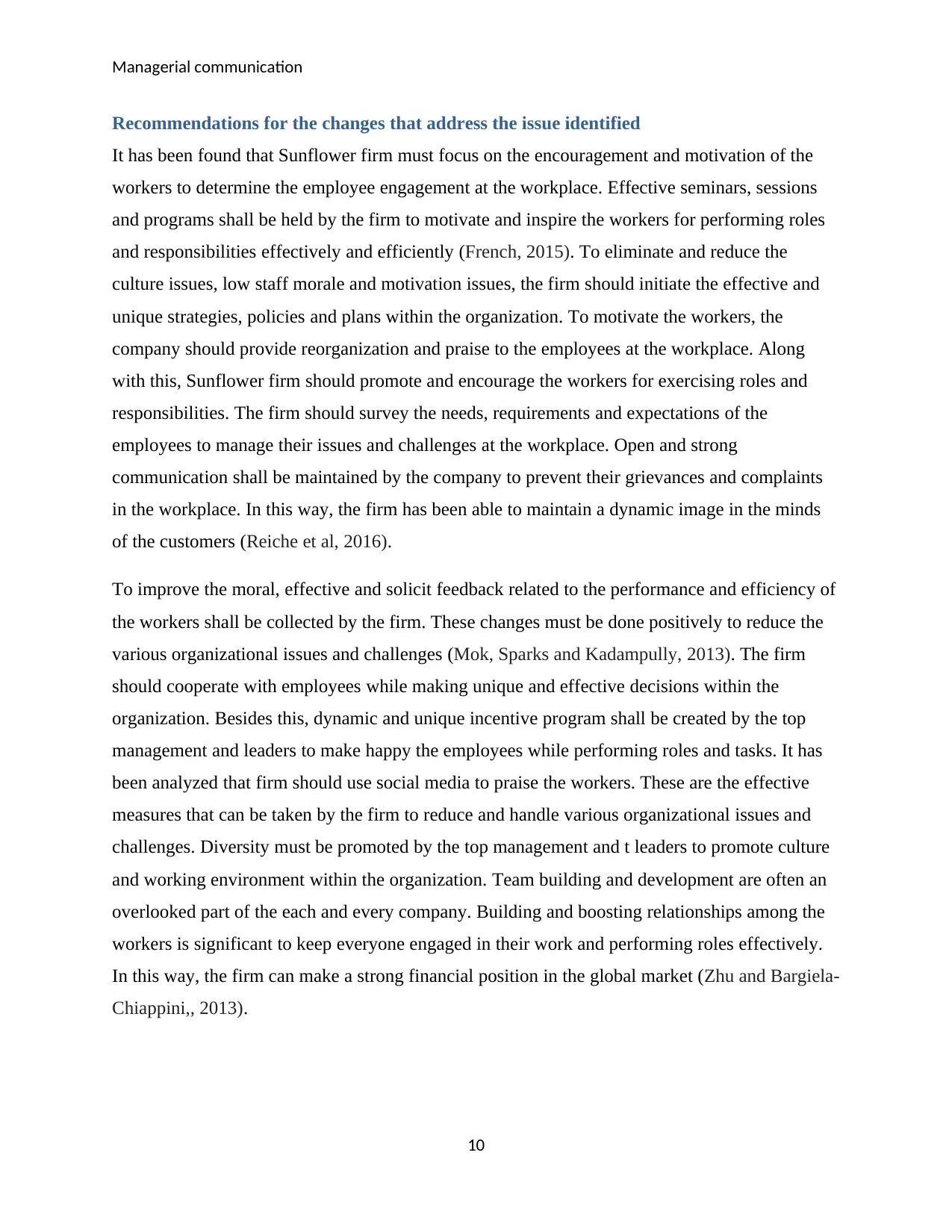
Managerial communication
Recommendations for the changes that address the issue identified
It has been found that Sunflower firm must focus on the encouragement and motivation of the
workers to determine the employee engagement at the workplace. Effective seminars, sessions
and programs shall be held by the firm to motivate and inspire the workers for performing roles
and responsibilities effectively and efficiently (French, 2015). To eliminate and reduce the
culture issues, low staff morale and motivation issues, the firm should initiate the effective and
unique strategies, policies and plans within the organization. To motivate the workers, the
company should provide reorganization and praise to the employees at the workplace. Along
with this, Sunflower firm should promote and encourage the workers for exercising roles and
responsibilities. The firm should survey the needs, requirements and expectations of the
employees to manage their issues and challenges at the workplace. Open and strong
communication shall be maintained by the company to prevent their grievances and complaints
in the workplace. In this way, the firm has been able to maintain a dynamic image in the minds
of the customers (Reiche et al, 2016).
To improve the moral, effective and solicit feedback related to the performance and efficiency of
the workers shall be collected by the firm. These changes must be done positively to reduce the
various organizational issues and challenges (Mok, Sparks and Kadampully, 2013). The firm
should cooperate with employees while making unique and effective decisions within the
organization. Besides this, dynamic and unique incentive program shall be created by the top
management and leaders to make happy the employees while performing roles and tasks. It has
been analyzed that firm should use social media to praise the workers. These are the effective
measures that can be taken by the firm to reduce and handle various organizational issues and
challenges. Diversity must be promoted by the top management and t leaders to promote culture
and working environment within the organization. Team building and development are often an
overlooked part of the each and every company. Building and boosting relationships among the
workers is significant to keep everyone engaged in their work and performing roles effectively.
In this way, the firm can make a strong financial position in the global market (Zhu and Bargiela-
Chiappini,, 2013).
10
Recommendations for the changes that address the issue identified
It has been found that Sunflower firm must focus on the encouragement and motivation of the
workers to determine the employee engagement at the workplace. Effective seminars, sessions
and programs shall be held by the firm to motivate and inspire the workers for performing roles
and responsibilities effectively and efficiently (French, 2015). To eliminate and reduce the
culture issues, low staff morale and motivation issues, the firm should initiate the effective and
unique strategies, policies and plans within the organization. To motivate the workers, the
company should provide reorganization and praise to the employees at the workplace. Along
with this, Sunflower firm should promote and encourage the workers for exercising roles and
responsibilities. The firm should survey the needs, requirements and expectations of the
employees to manage their issues and challenges at the workplace. Open and strong
communication shall be maintained by the company to prevent their grievances and complaints
in the workplace. In this way, the firm has been able to maintain a dynamic image in the minds
of the customers (Reiche et al, 2016).
To improve the moral, effective and solicit feedback related to the performance and efficiency of
the workers shall be collected by the firm. These changes must be done positively to reduce the
various organizational issues and challenges (Mok, Sparks and Kadampully, 2013). The firm
should cooperate with employees while making unique and effective decisions within the
organization. Besides this, dynamic and unique incentive program shall be created by the top
management and leaders to make happy the employees while performing roles and tasks. It has
been analyzed that firm should use social media to praise the workers. These are the effective
measures that can be taken by the firm to reduce and handle various organizational issues and
challenges. Diversity must be promoted by the top management and t leaders to promote culture
and working environment within the organization. Team building and development are often an
overlooked part of the each and every company. Building and boosting relationships among the
workers is significant to keep everyone engaged in their work and performing roles effectively.
In this way, the firm can make a strong financial position in the global market (Zhu and Bargiela-
Chiappini,, 2013).
10
Paraphrase This Document
Need a fresh take? Get an instant paraphrase of this document with our AI Paraphraser
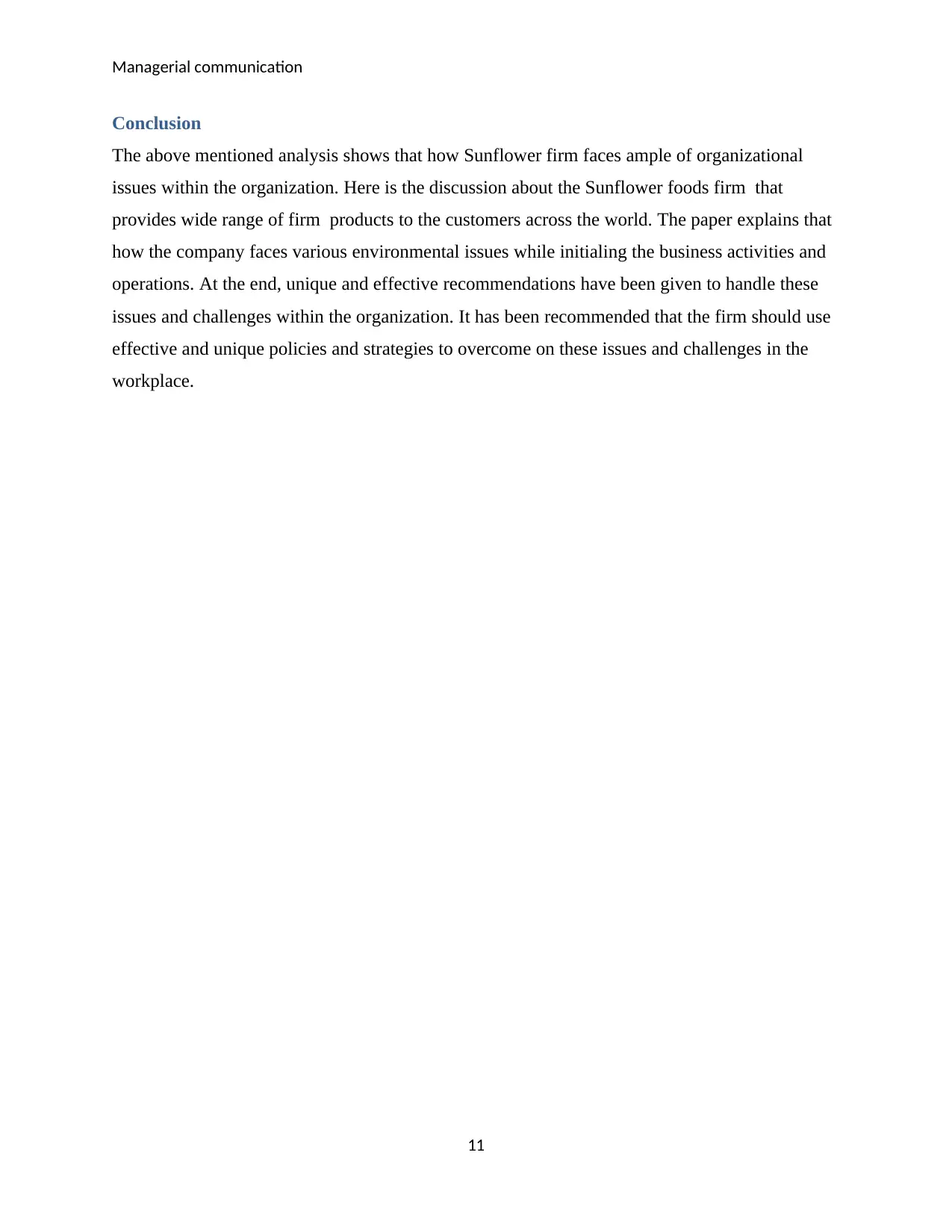
Managerial communication
Conclusion
The above mentioned analysis shows that how Sunflower firm faces ample of organizational
issues within the organization. Here is the discussion about the Sunflower foods firm that
provides wide range of firm products to the customers across the world. The paper explains that
how the company faces various environmental issues while initialing the business activities and
operations. At the end, unique and effective recommendations have been given to handle these
issues and challenges within the organization. It has been recommended that the firm should use
effective and unique policies and strategies to overcome on these issues and challenges in the
workplace.
11
Conclusion
The above mentioned analysis shows that how Sunflower firm faces ample of organizational
issues within the organization. Here is the discussion about the Sunflower foods firm that
provides wide range of firm products to the customers across the world. The paper explains that
how the company faces various environmental issues while initialing the business activities and
operations. At the end, unique and effective recommendations have been given to handle these
issues and challenges within the organization. It has been recommended that the firm should use
effective and unique policies and strategies to overcome on these issues and challenges in the
workplace.
11
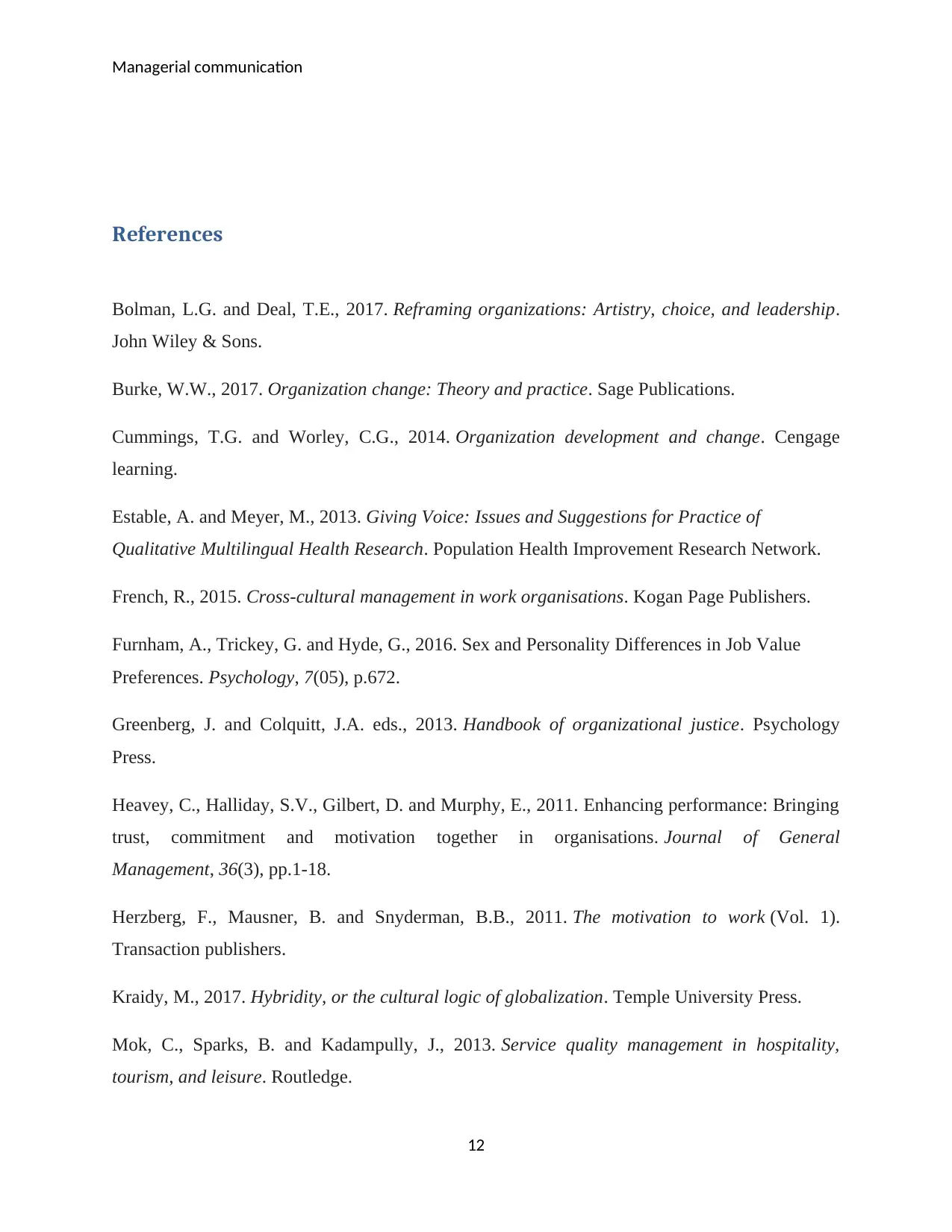
Managerial communication
References
Bolman, L.G. and Deal, T.E., 2017. Reframing organizations: Artistry, choice, and leadership.
John Wiley & Sons.
Burke, W.W., 2017. Organization change: Theory and practice. Sage Publications.
Cummings, T.G. and Worley, C.G., 2014. Organization development and change. Cengage
learning.
Estable, A. and Meyer, M., 2013. Giving Voice: Issues and Suggestions for Practice of
Qualitative Multilingual Health Research. Population Health Improvement Research Network.
French, R., 2015. Cross-cultural management in work organisations. Kogan Page Publishers.
Furnham, A., Trickey, G. and Hyde, G., 2016. Sex and Personality Differences in Job Value
Preferences. Psychology, 7(05), p.672.
Greenberg, J. and Colquitt, J.A. eds., 2013. Handbook of organizational justice. Psychology
Press.
Heavey, C., Halliday, S.V., Gilbert, D. and Murphy, E., 2011. Enhancing performance: Bringing
trust, commitment and motivation together in organisations. Journal of General
Management, 36(3), pp.1-18.
Herzberg, F., Mausner, B. and Snyderman, B.B., 2011. The motivation to work (Vol. 1).
Transaction publishers.
Kraidy, M., 2017. Hybridity, or the cultural logic of globalization. Temple University Press.
Mok, C., Sparks, B. and Kadampully, J., 2013. Service quality management in hospitality,
tourism, and leisure. Routledge.
12
References
Bolman, L.G. and Deal, T.E., 2017. Reframing organizations: Artistry, choice, and leadership.
John Wiley & Sons.
Burke, W.W., 2017. Organization change: Theory and practice. Sage Publications.
Cummings, T.G. and Worley, C.G., 2014. Organization development and change. Cengage
learning.
Estable, A. and Meyer, M., 2013. Giving Voice: Issues and Suggestions for Practice of
Qualitative Multilingual Health Research. Population Health Improvement Research Network.
French, R., 2015. Cross-cultural management in work organisations. Kogan Page Publishers.
Furnham, A., Trickey, G. and Hyde, G., 2016. Sex and Personality Differences in Job Value
Preferences. Psychology, 7(05), p.672.
Greenberg, J. and Colquitt, J.A. eds., 2013. Handbook of organizational justice. Psychology
Press.
Heavey, C., Halliday, S.V., Gilbert, D. and Murphy, E., 2011. Enhancing performance: Bringing
trust, commitment and motivation together in organisations. Journal of General
Management, 36(3), pp.1-18.
Herzberg, F., Mausner, B. and Snyderman, B.B., 2011. The motivation to work (Vol. 1).
Transaction publishers.
Kraidy, M., 2017. Hybridity, or the cultural logic of globalization. Temple University Press.
Mok, C., Sparks, B. and Kadampully, J., 2013. Service quality management in hospitality,
tourism, and leisure. Routledge.
12
⊘ This is a preview!⊘
Do you want full access?
Subscribe today to unlock all pages.

Trusted by 1+ million students worldwide
1 out of 13
Related Documents
Your All-in-One AI-Powered Toolkit for Academic Success.
+13062052269
info@desklib.com
Available 24*7 on WhatsApp / Email
![[object Object]](/_next/static/media/star-bottom.7253800d.svg)
Unlock your academic potential
Copyright © 2020–2025 A2Z Services. All Rights Reserved. Developed and managed by ZUCOL.





